#Software(NEC)
Explore tagged Tumblr posts
Text
SAP S/4HANA Cloud ERP software comes as a powerful technology meant to help firms simplify their processes, increase efficiency, and get real-time insights. Although this highly advanced software solution will help many businesses, some will stand to gain the most because of their particular requirements and challenges.
0 notes
Text
Amazon Prime Day occasion begins, gross sales up 12% in first 7 hours: Report | Firm Information
Prime Day can function a bellwether for the vacation procuring season. 3 min learn Final Up to date : Jul 17 2024 | 12:10 AM IST Amazon.com Inc.’s Prime Day gross sales rose virtually 12 per cent within the first seven hours of the occasion in contrast with the identical interval final 12 months, based on Momentum Commerce, which manages 50 manufacturers in a wide range of product…
#amazon#Amazon Prime#artificial intelligence#bank account#Check Point Software Technologies#counterfeit products#director of worldwide buyer risk prevention#E-commerce & Auction Services#e-commerce shoppers#eBay#Federal Trade Commission#Food Retail & Distribution (NEC)#HTTP#Internet & Mail Order Department Stores#Josh Planos#online hoaxes#online retailer#online shopping giant#Online shopping scams#phony products#public relations#retail calendar#Scott Knapp#Security Software#social media ads#vice president of communications and public relations#Walmart
0 notes
Text


My Home Dream / Victor Interactive Software (1994) - NEC PC98 My Home Dream 2 / Victor Interactive Software (1995) - NEC PC98
0 notes
Text
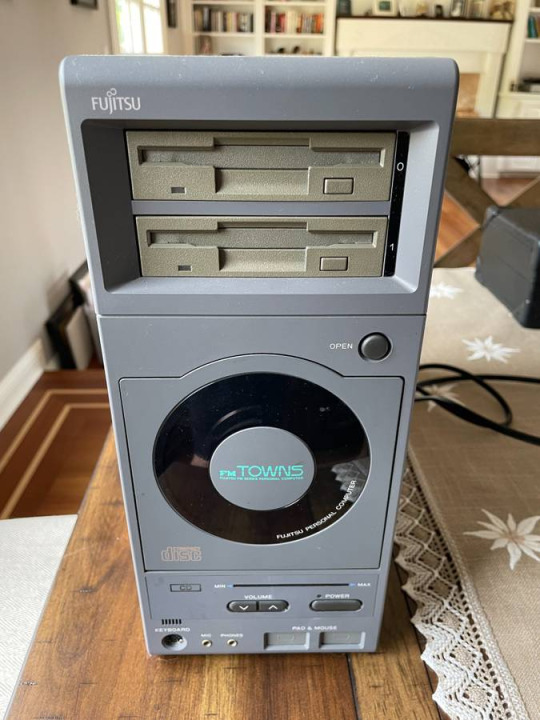
Fucking Gorgeous FM-Towns model 2F on craigslist near me. I don't have money or the knowledge to use this thing, but god it's amazing.

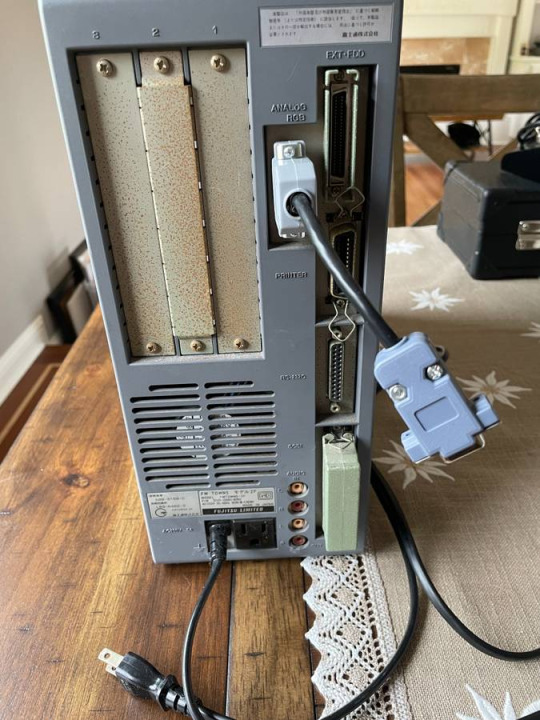
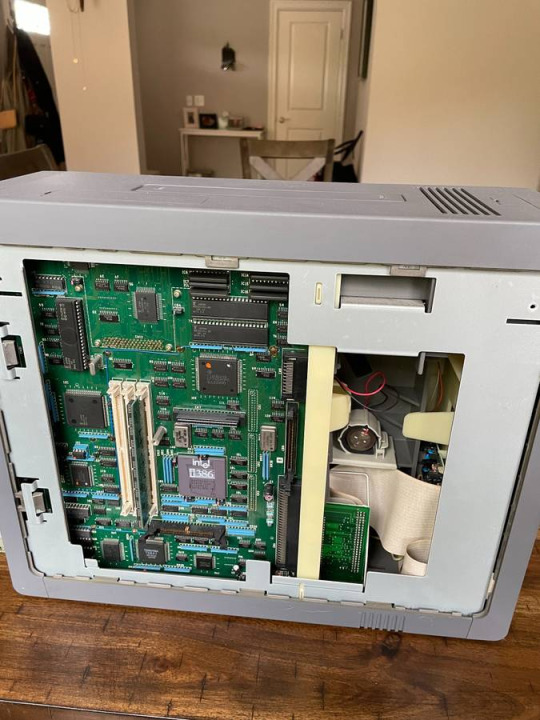
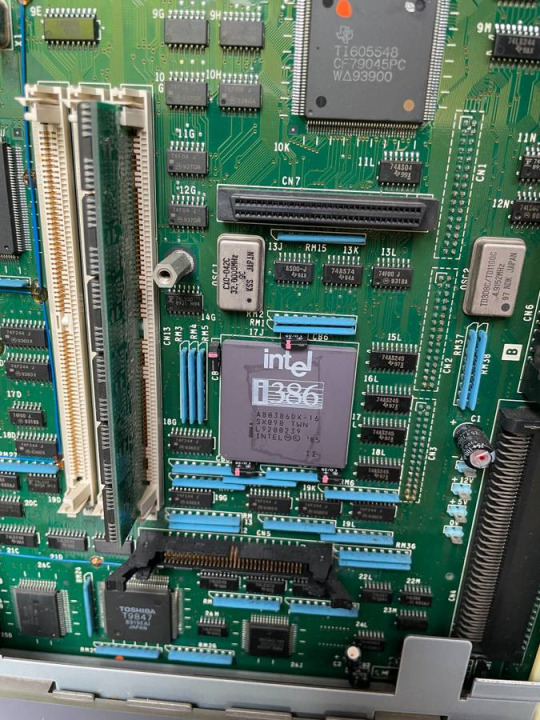
The FM Towns was a Fujitsu computer introduced in 1989 in Japan. It's built around an Intel 386, but it's not a fully PC compatible system. It ran Windows 3.x and Towns OS, which was built on top of MS-DOS and ran in 32-bit mode using an extender.
It didn't require a hard drive, booting the OS off the CD-ROM drive. It uses a custom graphics chip that's not VGA compatible, supporting sprites and overlays, with full kanji in ROM.
Audio-wise, it used a Yamaha OPN2, so it sounds much like a Sega Megadrive/Genesis.
Later systems added DOS/V (a version of MS-DOS designed for Japanese users) support, making it more like a MS-DOS computer.
There was also the FM Towns Marty, which made it into more of a console, looking less like a PC. This kept compatibility, however.

(This is, by the way, the only console to ship with a floppy drive standard)
Anyway these machines are neat and rare, but part of why they're rare is that they didn't sell very well. They're full computers so they're pretty expensive, and the FM Towns series was getting beaten by NEC's PC98 at first and then DOS/V clones later. They just didn't have the compatibility with DOS/V software to really justify them being a viable choice over the much cheaper DOS/V clones, and they had a smaller library than the much more popular PC98 series.
Still, they're very nifty machines.
Fun fact: They're called "FM Towns", right? FM is Fujitsu Micro, but "Towns" is the codename. They were named after the physicist Charles H. Townes, who did some of the fundamental work in the development of the maser, a predecessor to the laser, for which he shared a Nobel Prize in 1964.
You'll note his name is "Townes", but the system is "Towns". Futjitsu changed the spelling so that people would pronounce it correctly, rather than potentially pronounce it "tow-nes".
270 notes
·
View notes
Text
Early Texturing in Games
For the first arcade game with textures, Ridge Racer is one hell of a showing! Something like this running at 512x384 at 60FPS in '93 would only be matched when the Dreamcast released in 1998

The first game with hardware texturing was surprisingly in the home space: The aptly-named Crash 'n Burn for the 3DO, which came out with the system a few days before Ridge Racer that October. It would be the only 3DO game released in 1993. I don't know for sure, but I have a hunch that its extremely linear gameplay suggests it might be using a system where the vertices (polygon edge points) of the track/environment are pre-calculated and used for when the system actually draws the polygons at runtime, similar to Winter Gold ('96, SNES) or the intro of Silpheed ('86, NEC PC-8801mkIISR)
The first games to use texturing period were both software-rendered DOS games: Catacomb 3D and Ultima Underworld in '91 and '92 respectively.

Catacomb 3D is an Id Software game inspired by an early showing of Ultima Underworld at CES 1990, and it uses a software raycasting engine that would later be popularized by Wolfenstein 3D, Doom 1&2, and Duke Nukem 3D. Only the walls are textured, but hey, it was early days
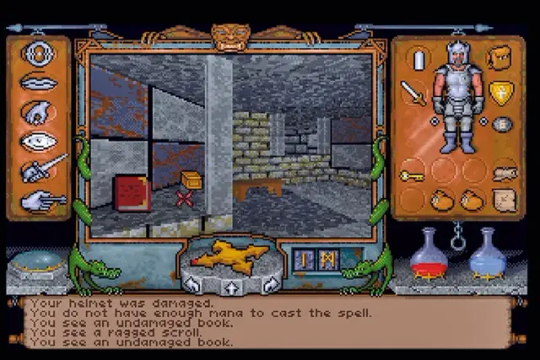
Ultima Underworld uses a software polygon renderer and is fully textured. It ended up directly inspiring Tomb Raider, and it's not hard to see why. Aside from the tiny viewport, severe texture warping and 2D objects, it's pretty comparable to King's Field 1 from '94 on the PS1!
24 notes
·
View notes
Text
OfficerKotohime's Big Touhou Masterpost
I've apparently convinced a few people to try Touhou through my posts, and I think that's neat. So I've decided to say, fuck it, let's talk about how to play Touhou. Maybe you've heard of the characters, the music, or read the print works but never tried out the games. I'm here to tell you it's easier to get into than you think. What is Touhou like? Generally the Touhou games are top down games where you shoot forward, enemies shoot back, and you dodge like your life depends on it. There are exceptions to this rule, like the fighting games. The Touhou games are generally distributed via disk, and they are only in Japanese. They are brisk games created by a single dev called ZUN. If you're more interested in lore there are the aforementioned print works. But if you want to play? This is the post for you! Don't speak Japanese? This is STILL the post for you! Disclaimer 1: I will not be discussing where to acquire the Touhou games illegally. Disclaimer 2: Touhou is really, really hard. It's not something I would sugarcoat. Disclaimer 3: Be careful downloading random stuff from the internet. I cannot ever promise nothing bad will happen to your computer.
With that being said, let's do this!
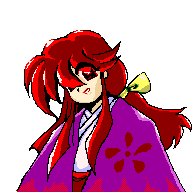
Ah, your danmaku is beautiful. Simply amazing. -Kotohime "Officerkotohime, which game do I start with?" The easy answer is that it's not terribly important. Many people say beginners should start with Imperishable Nights. That being said there are a lot of Touhou games. We're going to go at this chronologically. PC98 Games: The first five games were released for the NEC PC98. These games get overlooked often because of their age, inaccessibility, and the fact that ZUN more or less purged them from canon. But there are some genuinely good entries here, Like Mystic Square and Phantasmagoria of Dim.Dream.

Hm, you were just as strong as I expected.Which wasn't strong enough. -Mima
You can grab the English patches for all five PC98 games at the bottom of this page. There are detailed instructions in the file for getting these games up and running. A note, if you are acquiring your hdi (rom) files through external means you may be able to find prepatached ones already in English, and skip a few steps. Some useful software: The preferred PC98 emulator Locale Emulator (replaces applocale, which no longer exists) DiskExplorer
Again the instructions in the English patches are very good, but I may be able to answer simple questions if you get stuck.
"Officerkotohime, Lotus Land Story crashed!" Yeah it does that sometimes, if you figure it out let me know. Windows Games
From here on out you can get many different translations for each game via the Touhou Community Reliant Auto Patcher (ThCRAP)
ThCRAP is self-updating, stand alone software which can be set up to launch with your touhou games. VXpatch These patches apply for Touhou 6-15. They can help with vsync issues and other things like input slowdowns. VXpatch is MANDATORY for Embodiment of Scarlet Devil on windows 10 and up, due to an issue with it booting with unlimited framerate. Vxpatch can be integrated with your ThCRAP install, but requires some manual changes, which are described on the ThCRAP homepage.

sure, sure fight, fight - Reimu Touhou 6-8 The only legal means of acquiring these four (and yes I mean four) games is by purchasing the disks (sorry to disappoint) With any of the Windows touhou games you may run into an issue where ThCRAP tells you that you have the wrong version of the game installed. For these games you need to download and manually insert the updates into the game files. A note, these sites are in Japanese. Embodiment of Scarlet Devil Website Perfect Cherry Blossom Imperishable Night Files for Immaterial and Missing Power can be found on the touhou wiki
Phantasmagoria of Flower View, and everything after

I want to find a god with the gloomy power of love for my pets… -Koishi I'm so normal about Koishi guys
So here's where everything gets easier! Every Steam game from 9 on is available for purchase on Steam. They can be hard to look up, because they are in Japanese, but just pop Hakureishrine.org into your browser and it'll take you to a playlist of all of them. ThCRAP will work with you Steam touhou games as well. You can also select your game version within steam, so no downloading patches. Straight up that's it, we're done. Fangames
"Officerkotohime, I'm tired of losing at touhou but still want to play touhou." Fortunately ZUN is very open to people making games with his characters. There are way to many fangames to talk about, and in nearly any genre you can imagine. Want to play a metroidvania? We got those

Wanna play Mario Kart? Yup

We've even got some bizarre and uh... interesting stuff too.

(that image is from a fangame called haalluci-sabat of Koishi and it isn't really nsfw, but you know, just to be safe...) Safe for work Satori to the rescue I guess. For the record the majority of the touhous are adults, the style is just cutesy. It's a large and very old fandom. My point here is you really can find just about anything in terms of fanwork.
That's it. That's the post. This took over an hour. My asks are open if you have questions.
10 notes
·
View notes
Text
PC Engine - Battle Ace
Title: Battle Ace / バトルエース
Developer/Publisher: Hudson Soft
Release date: 30 November 1989
Catalogue No.: HC89026
Genre: Into-the-Screen Vertical Shooter
Format: SuperGrafx


There were rumors of a PC Engine successor brewing up in 1989, as competition was coming from Sega's Mega Drive and Nintendo's upcoming Super Famicom. It was tentatively dubbed the PC Engine II. Something must have gone horribly wrong because instead, the SuperGrafx was born. The SuperGrafx was built on top of the PC Engine's core technology, except with a few upgrades here and there. When it was launched, reception from the gaming press and public in Japan was so cold that NEC and Hudson gave up on the SuperGrafx dream after 2 years and only 7 titles taking advantage of it. Despite the fact the SuperGrafx was backward-compatible with the entire PC Engine library, the price was too high, the software was too few - costing over US$100 each per game, and its proposition to compete against the Mega Drive and Super Famicom was unrealized.
When the system was launched on 30 November 1989, only one launch game was released, and it stayed like this for months, called Battle Ace. The main problem with Battle Ace is that it's rubbish! While I've not got anything against the genre - I love After Burner, and Space Harrier is my all-time favorite arcade game - anyone buying this with their brand new SuperGrafx must have wondered what made them waste their hard-earned cash. The gameplay is mind-numbingly repetitive without being enjoyable, and the graphics are extremely bland - you rarely see the enemy ships as anything bigger than a few dots as you've either destroyed them or they've gone whizzing off. Also, the levels are overly long and while the music is quite racy, it's not catchy or technically good enough to relieve the monotony. Quite how a company like Hudson had the nerve to release this trash is beyond me.





youtube
2 notes
·
View notes
Text




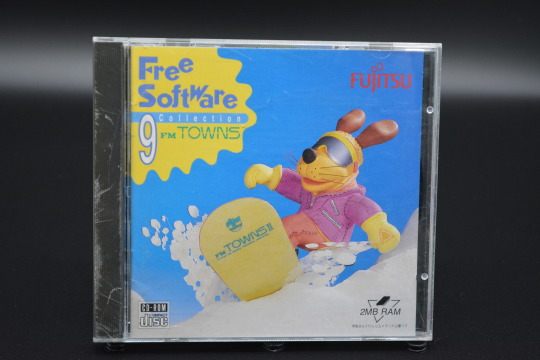

I don't really feel like getting into emulating FM Towns right at this moment since a lot of old Windows, DOS and NEC PC-98 stuff are already giving me a lot headaches...
But I love the cover artworks made for Fujitsu's Free Software Collection CDs for FM Towns :3
14 notes
·
View notes
Text
Henk Roger in Chile
Henk Roger (actual CEO with Axeley Pajitnov of The Tetris Company), is a Game Programmer, Game Designer, various games, and Chief Executive of game companies, he arrived in Chile for Festigame 2023 on the 12 and 13 of August! I went on Saturday and I got to know him, he could sign me some Bullet Proof Software (best known as B.P.S too) games.
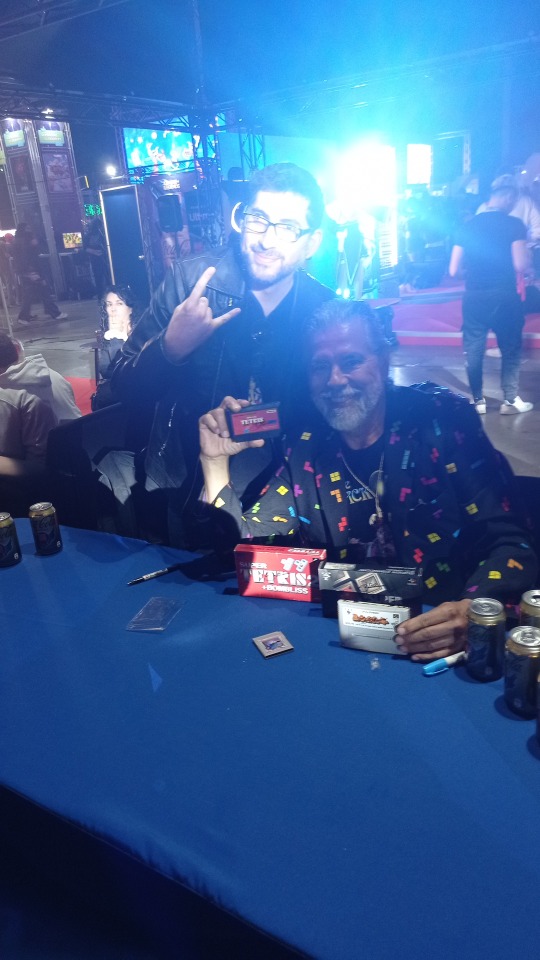


Was so fantastic his interview on the main stage of FestiGames. I will tell you the trajectory of Henk Roger before and later of Tetris.
The Birth of Bullet Proof Software
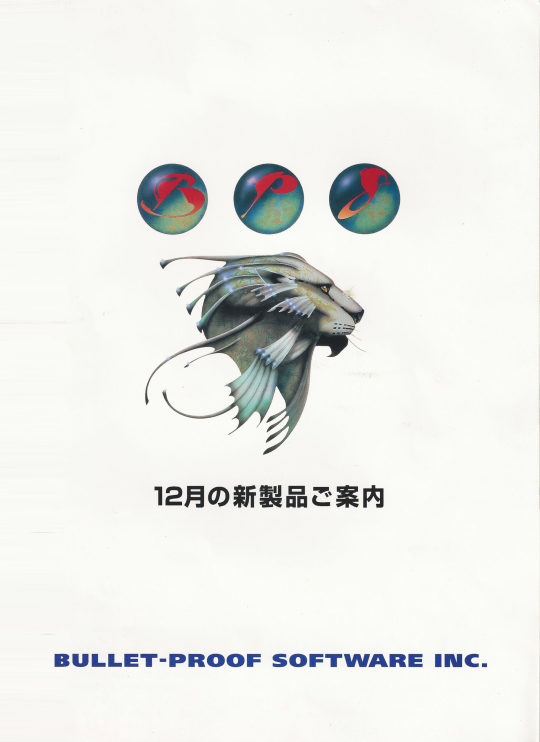
Bullet Proof Software (known as B.P.S) was an American/Japanese game Developer and Publisher founded by Henk Roger in 1983 in Japan. In the next year, the first game developed by B.P.S was Black Onyx, which was the first introduction of the RPG (Role Playing Game)/ Dungeon Crawler genre for the gamer Japanese before they developed games such as Dragon Quest (Enix), YS (Nihon Falcom) or Final Fantasy (Squaresoft).
Black Onyx had Inspiration from successful American RPGs like Ultima by Richard Garriot in 1981, and Wizardry by Andrew C. Greenberg and Robert Woodhead in 1981, obviously, those games are based on Dungeon & Dragon (a tabletop game created in 1974 by David Gygax and Dave Anderson), the original mother of all Rol Playing games.
Its development was for NEC-PC 88, NEC-PC 98, SEGA-1000 and, and had a sequel for Famicom called Super Black Onyx.

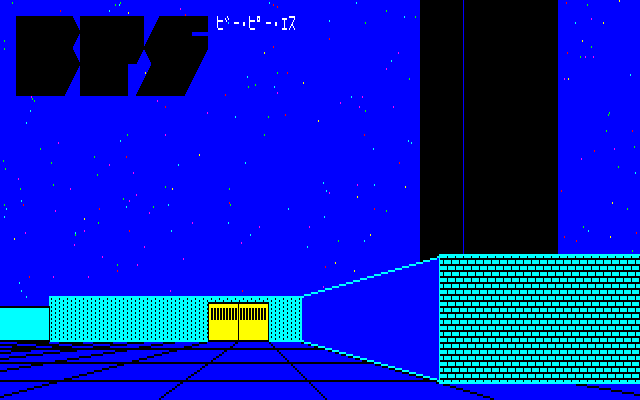

"Black Onyx for NEC PC 88 (hardware Japanese of 8 bits)"

"The Original Team of B.P.S during the development of Black Onyx in 1984"
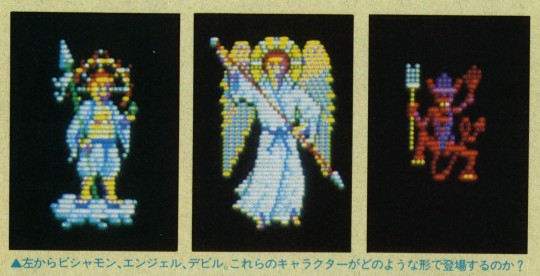

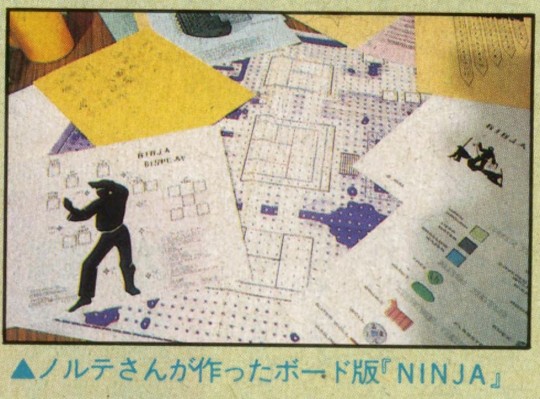
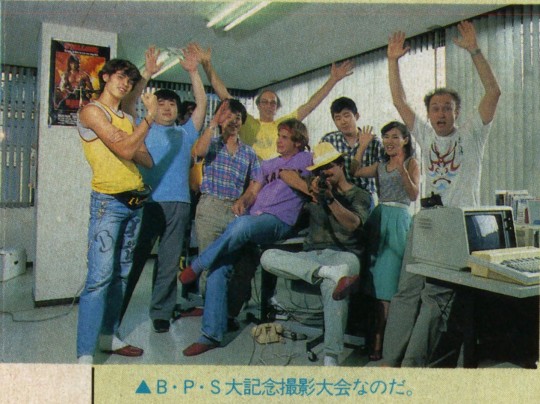
"Bullet Proof Software Office in 1984, the screenshots are of a Japanese Magazine called Beep! about videogame, 1984 which they worked on in Black Onyx's Third chapter, showed GDD and Sprite Editor that was unreleased". (source by VGDenetsu)


B.P.S Club Ad, show the next game for PC 88 and Famicom like: -MicroGo1 (1987 developed by B.P.S for Famicom) is a Go game -Archon (they were the publisher for the PC 88/FM 77 version in 1986) -Lyrane (they were the publisher for the PC 88/FM 77 version in 1986 and 1987)
Tetris, From Russia with Love:

I suggest you check the great documental: "From Russian with Love" created by BBC, but I will try to resume the story: Axeley Pajitnov's 1985 program Tetris his Electronika 60 in the Science Sovietic Academy of Moscu during the URRS, his creation did not have the proprietary right concept, the game was spread all over Europe. The game quickly arrived on different PCs until you reached a Computation Exposition in Europe. A man called Robert Stein from Andromeda Software was interested in Tetris, and he wanted to contact Axeley Pajitnov, but the Soviet government was awarded the game to negotiate with any wanted of getting the rights of commercialization for selling Tetris via Elorg, Ministry of Technology of the government.
Elorg sent the first step for negotiating to Robert Stein, but him believed that was a contract for the right of commercialization, he started selling the rights commercialization to Mirror Soft (a British Company created by the Multibilionaire Robert Maxwell), This company sold the rights to Spectrum Holobyte (game developer and Publisher in the USA) that this sold the rights to Atari Tengen (for Arcade and Console) and finally Atari Tengen sold the rights to Henk Roger from Bullet Proof Software for can sell Tetris for Famicom, during a CES of 1987.
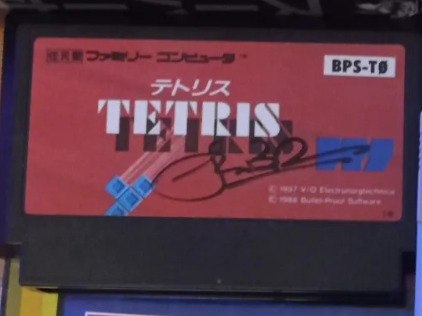
"This was the first version of Tetris for Famicom released in 1987, that didn't same NES version released in 1989 was developed by Nintendo Japan". But Elorg didn´t know about the commercialization of Tetris in anything platform until 1988, when they saw the different Tetris versions on PC. Elorg contacted Robert Stein because he traded the rights without Elorg's permission., while Mirror Soft at the same time they wanted the rights to Tetris, and Henk Roger was contacted by Hiroshi Yamauchi because Nintendo they worked on a new Console Portable: Game Boy. Henk Roger, Robert Stein, and Kevin Maxwell made a trip to URRS, to negotiate the complete rights of Tetris, without knowing each one traveled with the same intention, was a legal fight and very bureaucratic, and this scaled to the KGB, Kremlin, and finally to the Mijain Gorbachov, but Henk Roger got the exclusive rights for develop and sell the game for Game Boy and VideoGame Home Console. With the rights to the Video Game Home Console, They can stop and cancel the version of Atari Tengen for NES, obviously, Atari demanded Nintendo in a Legal Trial for the rights to sell the Home Console (at this moment ATARI made a re-engineer inverse to the NES for manufacture own NES Cartridge without permission of Nintendo they had another legal trial).

In 1989, Tetris was sold with the release of the Game Boy, which was developed by Bullet Proof Sofware, It was a success for Nintendo and BPS, but Axeley Pajitnov at all times earned nothing from the profits of his creation, Elorg and URRS kept the profits until 1996 when Russia change to the capitalist system and rights of creation were delivered for his creator.
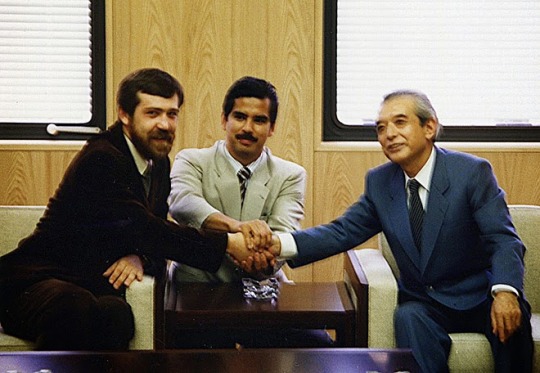
Axeley Pajitnov, Henk Roger and Hiroshi Yamauchi (President of Nintendo Kyoto in 1989)
Testris and the Friendship:
Axeley Pajitnov wanted to work as a Game designer and work in the game industry, and his best friend could help. Bullet Proof Software since 1989, opened a filial of development in Redmond Washington (very near the Nintendo of America office), Axeley Pajitnov could exit to the URRS, and traveled to the United States with his family. His first work in B.P.S was: - WellTris - FaceTris - HaTris - Knight Moves - PipeDream ( based on the PC game of Lucas Film Game) - Yoshi Cookies (based on an unreleased arcade game of HomeData) Later Pajitnov worked at Microsoft and in 1996 he founded with Henk Roger, The Tetris Company.
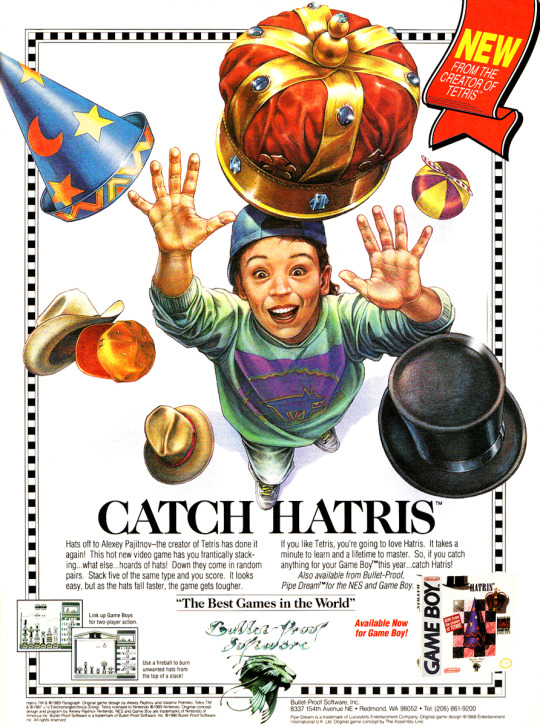

"Hatris and PipeDream was the next game designed by Axeley Pajitnov after Tetris, Facetris & Welltris"

"An article from 1990 by GamePro Magazine (Review of Hatris & Pipe Dreams Puzzle Games for Game Boy)"

"Club Nintendo Magazine, CES of 1993"


"Ads of some Game of Bullet Proof Software".
2 notes
·
View notes
Text
A journey through Sega's marketing machine with the power of the cassette
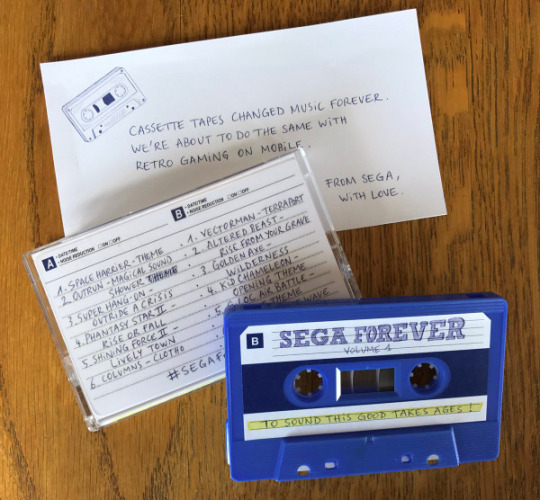
I know, I know, a bit of a wild stretch to start this blog off without some proper introduction. Hi. I'm archonedd / Nobusuke, and I'm an avid (at the time of publication) 23 year old Sega (and Sonic) nut.
After mercilessly mocking cassettes as some old fad throughout the elementary and high school years as the world started gravitating more and more towards online streaming, I picked up a cassette player in early 2017 no doubt due to the hype surrounding a cassette that Star-Lord was seen playing on repeat on one of the Guardians of the Galaxy movies. Along with said cassette player, came a Type 1 cassette tape to play. It changed my music experience in ways I'd never imagined, and I even tried substituting my CD-based boombox with one of these and needless to say the equipment left a lot to be desired.
It turns out that modern cassette players just don't have the quality mechanisms that legacy cassette decks used to have, and the number of new cassette-enabled devices seem to be dwindling globally as time goes on. Not to mention, most people's recollections of cassettes seems to border towards "listening to a crappy stream from the car's radio" to "only listening to a film's vision of what cassettes or any other vintage audio format used to sound like".
It sure took a YouTube channel like Techmoan and Retro Core AV as well as several others where my outlook on cassettes (and several vintage audio formats) began to change a little as I learned more about the different types of cassettes, and how cassettes can sound a lot like or even close to a properly mastered CD if given the right budget and expectations. So imagine my surprise when I heard almost 5 years later that Sega even started using distributing cassettes dubbed "Sega Forever Volume 1". My initial reaction was - "Wait a minute. What??"
What is this tape about?
Basically the idea of this was to serve as a promotional item sent out to various YouTubers and Sega-centric content creators prior to the launch of the "SEGA Forever" service on mobile devices. The tracks on these are basically taken from popular arcade and Mega Drive/Genesis titles, some of which are still remembered to this day.
The most remembered ones include the arcade BGM to Space Harrier and Outrun, as well as those from Mega Drive standout classics like Phantasy Star 2, Shining Force 2, and even Vectorman (a Blue Sky Software effort) gets a special shoutout though only Terraport from that game gets represented. Overall, there are 12 songs spread into two sides of six.
The strange thing is some of the Sega arcade titles even got console ports on non-Sega systems usually through third parties like Sunsoft and NEC Avenue.
Here is the complete tracklist in case you may not remember.
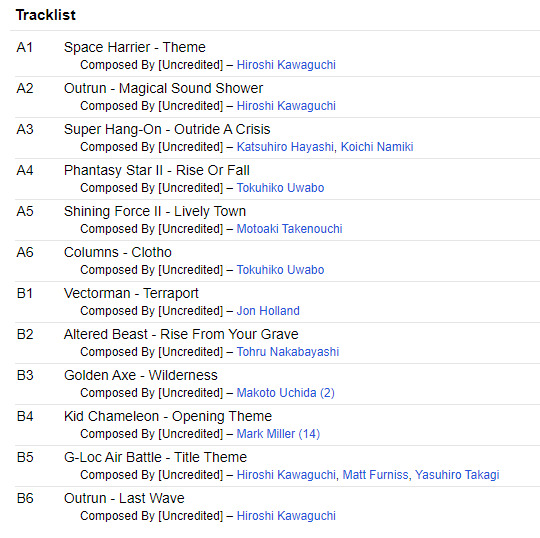
For the lucky 512 or so content creators lucky enough to receive this retro blast, the package even included a biro pen just in case your cassette player somehow "ate the tape" and you're on the task to spool the tape back in. You, know, like the old days where cassette enjoyers did it. I personally do not have such a strong nostalgic connection, but I just found it interesting to mention.

What are the technical specifications?
There are four types of cassettes sold throughout the market during the continuing lifespan of these audio wonders.
Type 1 refers to a general cassette you are most likely to buy today. This is known as a "Ferric" tape.
Type 2 known as "Chrome" is a step up from Type 1. While it is a general step up from Type 1 tapes, in the end, quality Type I cassettes have higher midrange MOL than most Type II tapes, slow and gentle MOL roll-off at low frequencies, but less treble headroom than Type II.
Type 3 "Ferrichrome" doesn't really exist anymore as far as I can tell.
Type 4 is the supreme stuff. These are called "Metal" tapes. To play such a high-class tape, your deck or player would have to be rated for metal tape playback. Something that today's modern tapes aren't quite capable of playing now, or at least I don't think so.
It seems more likely that Sega Forever Volume 1 cassette is a Type 1 metal tape with no noise reduction to speak of. These days, Dolby noise reduction may be no more, but substitutes such as DDi Codec will be able to alleviate that.
Sega Forever....

Let's talk about Sega Forever. Sega Forever was a then-new initiative to get its best retro games available for a mobile audience that's still going today. Very similar to what they are already doing with Sega Mega Drive Classics on multiplatform experiences via PC, PS4 and XBOX. This cassette was to coincide with the launch of the Sega Forever platform on smartphone on 21 June 2017, with the initial lineup being Altered Beast/Jyuohki, Comix Zone, Chameleon Kid, Sonic the Hedgehog 1 and Phantasy Star II.
Unfortunately it had a somewhat rocky launch. With the exception of the rebooted Sega Forever Sonic the Hedgehog mobile conversion handled by Stealth (the same guy that demoed what Sonic could look like on the GBA compared to the half-baked effort Sega of America pumped out in 2006), almost the entirety of the selection ran poorly despite modern hardware enhancements. It seemed to be a middleware problem as Sega reportedly failed to reach an agreement with the people behind the Retroarch project, instead settling for a Unity-based emulation solution.
Since then, Sega have upped the quality of the emulation for the smartphones of our time.
2 notes
·
View notes
Text
Understanding MEP Drawings and Their Impact on Construction Projects

Understanding MEP drawings for successful construction projects is very much crucial. MEP drawings include mechanical, electrical, and plumbing systems essential for building functionality. These drawings, often facilitated through MEP drafting services, help engineers and contractors create precise layouts for HVAC units, electrical wiring, and plumbing. Revit and AutoCAD MEP are commonly used software tools to generate detailed MEP drawings, ensuring accuracy and coordination. The use of Building Information Modeling (BIM) streamlines MEP coordination, reducing errors and rework. MEP drawings are also compliant with industry standards like ASHRAE, NFPA, and NEC, ensuring designs meet safety and regulatory requirements for various building types.
For recommendations, you might explore MEP Drawing services of Tejjy Inc., in Maryland, USA. You can also check their platforms like LinkedIn, industry forums, or professional networks for vetted service providers.
0 notes
Photo

Tax season for small business owners be like 😅🗂️: 🚀 Pro-tip: Stay ahead and keep those crucial docs in check all year long. Here's what you need: 💰 Income records: Bank statements, invoices, sales receipts. Don't forget 1099-NEC if you're a contractor. 🧾 Expense records: Receipts, invoices for purchases like supplies, software, and more. Keep tabs on home office expenses if you're WFH 🏠 🗃️ Business structure docs: Formation paperwork, EIN, and past tax returns. Trust us, keeping organized will save you from a headache later. Plus, don't miss out on potential deductions. Got questions? A tax pro is your bestie! #SmallBusiness #TaxSeason #StayOrganized #BusinessTips #TumblrCommunity
1 note
·
View note
Text
Inventory Management Software Market: Trends, Forecast, and Competitive Landscape 2032
Inventory Management Software Market Growth, Demand and Forecast 2032
The Inventory Management Software Market sector is undergoing rapid transformation, with significant growth and innovations expected by 2032. In-depth market research offers a thorough analysis of market size, share, and emerging trends, providing essential insights into its expansion potential. The report explores market segmentation and definitions, emphasizing key components and growth drivers. Through the use of SWOT and PESTEL analyses, it evaluates the sector’s strengths, weaknesses, opportunities, and threats, while considering political, economic, social, technological, environmental, and legal influences. Expert evaluations of competitor strategies and recent developments shed light on geographical trends and forecast the market’s future direction, creating a solid framework for strategic planning and investment decisions.
Brief Overview of the Inventory Management Software Market:
The global Inventory Management Software Market is expected to experience substantial growth between 2024 and 2032. Starting from a steady growth rate in 2023, the market is anticipated to accelerate due to increasing strategic initiatives by key market players throughout the forecast period.
Get a Sample PDF of Report - https://www.databridgemarketresearch.com/request-a-sample/?dbmr=global-inventory-management-software-market
Which are the top companies operating in the Inventory Management Software Market?
The report profiles noticeable organizations working in the water purifier showcase and the triumphant methodologies received by them. It likewise reveals insights about the share held by each organization and their contribution to the market's extension. This Global Inventory Management Software Market report provides the information of the Top Companies in Inventory Management Software Market in the market their business strategy, financial situation etc.
Manhattan Associates, (U.S.), Blue Yonder Group, Inc. (U.S.), HighJump (U.S.), Oracle (U.S.), IBM Corporation (U.S.), SAP SE (Germany), ACL Digital (U.S.), VMWare Inc. (U.S.), Telefonaktiebolaget LM Ericsson. (Sweden), Hewlett Packard Enterprise Development LP (U.S.), Softeon (U.S.), Telco Systems (U.S.), NEC Corporation (Japan), Juniper Networks Inc.(U.S.), Infor. (U.S.), Versa Networks Inc., (U.S.) and Cisco Systems Inc.(U.S.)
Report Scope and Market Segmentation
Which are the driving factors of the Inventory Management Software Market?
The driving factors of the Inventory Management Software Market are multifaceted and crucial for its growth and development. Technological advancements play a significant role by enhancing product efficiency, reducing costs, and introducing innovative features that cater to evolving consumer demands. Rising consumer interest and demand for keyword-related products and services further fuel market expansion. Favorable economic conditions, including increased disposable incomes, enable higher consumer spending, which benefits the market. Supportive regulatory environments, with policies that provide incentives and subsidies, also encourage growth, while globalization opens new opportunities by expanding market reach and international trade.
Inventory Management Software Market - Competitive and Segmentation Analysis:
**Segments**
- **Deployment**: Cloud-based, On-premises - **Organization Size**: Small and Medium-sized Enterprises (SMEs), Large Enterprises - **Verticals**: Retail and e-commerce, Manufacturing, Healthcare, Automotive, Others
The global inventory management software market is projected to witness substantial growth by the year 2032. With the increasing demand for efficient inventory management solutions across various industries, the market is expected to expand at a considerable rate during the forecast period. The deployment segment, including cloud-based and on-premises solutions, is anticipated to experience significant adoption as organizations seek scalable and cost-effective inventory management systems. Furthermore, the choice between cloud-based and on-premises deployment largely depends on factors such as data security, customization requirements, and IT infrastructure.
In terms of organization size, both small and medium-sized enterprises (SMEs) and large enterprises are likely to contribute significantly to the market growth. SMEs are increasingly recognizing the value of inventory management software in optimizing operations and enhancing productivity. On the other hand, large enterprises are investing in advanced solutions to manage complex supply chains and diverse product portfolios effectively. This diversity in the target customer base is expected to drive market growth across different organization sizes.
Across various verticals such as retail and e-commerce, manufacturing, healthcare, automotive, and others, the adoption of inventory management software is gaining momentum. The retail and e-commerce sector, in particular, is witnessing a surge in demand for real-time inventory tracking and order fulfillment capabilities to meet customer expectations efficiently. Similarly, the manufacturing industry is leveraging inventory management software to streamline production processes, reduce lead times, and minimize wastage. In healthcare, accurate inventory management is critical for ensuring the availability of medical supplies and equipment, thereby improving patient care outcomes.
**Market Players**
- Oracle Corporation - SAP SE - IBM Corporation - Microsoft Corporation - Infor Inc. - Epicor Software Corporation - JDA Software Group, Inc. - Netsuite Inc. The global inventory management software market is a highly competitive landscape with several key players dominating the industry. Companies like Oracle Corporation, SAP SE, IBM Corporation, and Microsoft Corporation have established a strong presence in the market by offering comprehensive inventory management solutions tailored to meet the diverse needs of businesses across various sectors. These industry giants leverage their technological expertise and global reach to provide customers with innovative products and services that drive operational efficiency and strategic decision-making.
In addition to the established players, emerging software vendors such as Infor Inc., Epicor Software Corporation, JDA Software Group, Inc., and Netsuite Inc. are also making significant strides in the market. These companies focus on developing scalable and user-friendly inventory management solutions that cater to the evolving needs of modern businesses. By harnessing the power of data analytics, artificial intelligence, and machine learning, these players are equipping organizations with advanced tools to optimize inventory levels, reduce stockouts, and improve supply chain visibility.
The market dynamics of the inventory management software sector are influenced by a myriad of factors, including technological advancements, shifting consumer preferences, regulatory compliance requirements, and macroeconomic trends. As businesses strive to achieve operational excellence and cost savings, the demand for sophisticated inventory management solutions is expected to rise. This creates opportunities for software providers to introduce cutting-edge features such as predictive analytics, demand forecasting, and real-time inventory tracking to stay ahead of the competition.
Moreover, the COVID-19 pandemic has underscored the importance of resilient supply chains and efficient inventory management practices. Organizations across industries are now reevaluating their inventory planning strategies to mitigate risks and adapt to the changing market dynamics. This renewed focus on inventory optimization is driving the adoption of cloud-based inventory management software, which offers flexibility, scalability, and remote access capabilities to support distributed work environments.
Looking ahead, the future of the inventory management software market is poised for robust growth as businesses increasingly prioritize agility, visibility, and automation in their supply chain operations. Software vendors that can deliver comprehensive solutions that address the unique challenges**Market Players**
- Manhattan Associates (U.S.) - Blue Yonder Group, Inc. (U.S.) - HighJump (U.S.) - Oracle (U.S.) - IBM Corporation (U.S.) - SAP SE (Germany) - ACL Digital (U.S.) - VMWare Inc. (U.S.) - Telefonaktiebolaget LM Ericsson (Sweden) - Hewlett Packard Enterprise Development LP (U.S.) - Softeon (U.S.) - Telco Systems (U.S.) - NEC Corporation (Japan) - Juniper Networks Inc. (U.S.) - Infor (U.S.) - Versa Networks Inc. (U.S.) - Cisco Systems Inc. (U.S.)
The global inventory management software market is poised for significant growth driven by the increasing demand for efficient solutions across diverse industries by the year 2032. The deployment segment, encompassing cloud-based and on-premises solutions, is expected to witness substantial adoption as organizations look for scalable and cost-effective inventory management systems to streamline their operations. Both small and medium-sized enterprises (SMEs) and large enterprises are anticipated to contribute significantly to the market growth, with SMEs recognizing the value of such software in optimizing operations, while large enterprises invest in advanced solutions to manage complex supply chains effectively.
Across verticals like retail and e-commerce, manufacturing, healthcare, automotive, and others, the adoption of inventory management software is gaining traction. Industries such as retail and e-commerce are
North America, particularly the United States, will continue to exert significant influence that cannot be overlooked. Any shifts in the United States could impact the development trajectory of the Inventory Management Software Market. The North American market is poised for substantial growth over the forecast period. The region benefits from widespread adoption of advanced technologies and the presence of major industry players, creating abundant growth opportunities.
Similarly, Europe plays a crucial role in the global Inventory Management Software Market, expected to exhibit impressive growth in CAGR from 2024 to 2032.
Explore Further Details about This Research Inventory Management Software Market Report https://www.databridgemarketresearch.com/reports/global-inventory-management-software-market
Key Benefits for Industry Participants and Stakeholders: –
Industry drivers, trends, restraints, and opportunities are covered in the study.
Neutral perspective on the Inventory Management Software Market scenario
Recent industry growth and new developments
Competitive landscape and strategies of key companies
The Historical, current, and estimated Inventory Management Software Market size in terms of value and size
In-depth, comprehensive analysis and forecasting of the Inventory Management Software Market
Geographically, the detailed analysis of consumption, revenue, market share and growth rate, historical data and forecast (2024-2032) of the following regions are covered in Chapters
The countries covered in the Inventory Management Software Market report are U.S., Canada, Mexico, Brazil, Argentina, Rest of South America, Germany, Italy, U.K., France, Spain, Netherlands, Belgium, Switzerland, Turkey, Russia, Rest of Europe, Japan, China, India, South Korea, Australia, Singapore, Malaysia, Thailand, Indonesia, Philippines, Rest of Asia-Pacific, Saudi Arabia, U.A.E, South Africa, Egypt, Israel, and Rest of the Middle East and Africa
Detailed TOC of Inventory Management Software Market Insights and Forecast to 2032
Part 01: Executive Summary
Part 02: Scope Of The Report
Part 03: Research Methodology
Part 04: Inventory Management Software Market Landscape
Part 05: Pipeline Analysis
Part 06: Inventory Management Software Market Sizing
Part 07: Five Forces Analysis
Part 08: Inventory Management Software Market Segmentation
Part 09: Customer Landscape
Part 10: Regional Landscape
Part 11: Decision Framework
Part 12: Drivers And Challenges
Part 13: Inventory Management Software Market Trends
Part 14: Vendor Landscape
Part 15: Vendor Analysis
Part 16: Appendix
Browse More Reports:
Data Bridge Market Research:
Today's trends are a great way to predict future events!
Data Bridge Market Research is a market research and consulting company that stands out for its innovative and distinctive approach, as well as its unmatched resilience and integrated methods. We are dedicated to identifying the best market opportunities, and providing insightful information that will help your business thrive in the marketplace. Data Bridge offers tailored solutions to complex business challenges. This facilitates a smooth decision-making process. Data Bridge was founded in Pune in 2015. It is the product of deep wisdom and experience.
Contact Us:
Data Bridge Market Research
US: +1 614 591 3140
UK: +44 845 154 9652
APAC: +653 1251 1682
Email:- [email protected]
#Inventory Management Software Market#Inventory Management Software Market size#Inventory Management Software Market scope
0 notes
Text
NEC Exclusive-Japan weighs a proposal for CSG software provider systems, sources say
By Milea coming New York (Reuters) – NEC Corp. Japanese Technology Group has been talking to its advisers about the possibility of bidding for CSG systems, which provides customers' care solutions and bills for cable and telephone companies People who are familiar with the matter. NEC from Tokyo has been working with Investment Bankers at Morgan Stanley on a possible CSG offer, which has examined…
0 notes
Text
NEC Exclusive-Japan weighs a proposal for CSG software provider systems, sources say
By Milea coming New York (Reuters) – NEC Corp. Japanese Technology Group has been talking to its advisers about the possibility of bidding for CSG systems, which provides customers' care solutions and bills for cable and telephone companies People who are familiar with the matter. NEC from Tokyo has been working with Investment Bankers at Morgan Stanley on a possible CSG offer, which has examined…
0 notes
Text
NEC Exclusive-Japan weighs a proposal for CSG software provider systems, sources say
By Milea coming New York (Reuters) – NEC Corp. Japanese Technology Group has been talking to its advisers about the possibility of bidding for CSG systems, which provides customers' care solutions and bills for cable and telephone companies People who are familiar with the matter. NEC from Tokyo has been working with Investment Bankers at Morgan Stanley on a possible CSG offer, which has examined…
0 notes